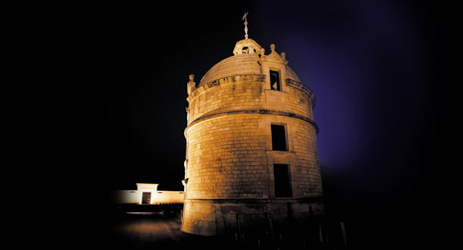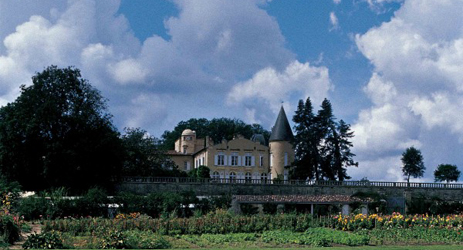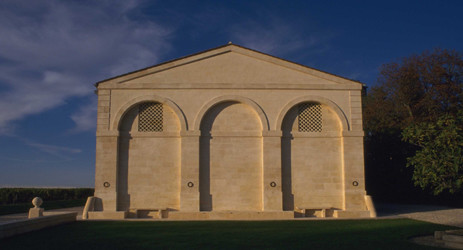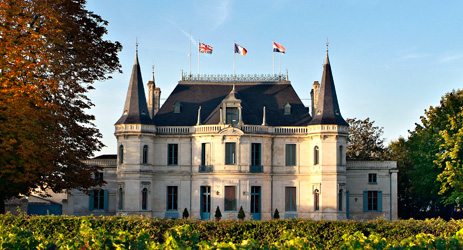5th Cru Classe, 1855
Quai Antoine Ferchaud,
33250 Pauillac
+33 (0)556 59 00 40
www.grandpuyducasse.fr

Location: AOC Pauillac.Production: 40 hectares, split into three large plots, producing between 100,000-120,000 bottles per vintage.
Five things you didn't know about Chateau Grand-Puy Ducasse:
- Owner Credit Agricole Grands Crus is the largest viticultural landowner in Bordeaux, and its headquarters are here, at Chateau Grand-Puy Ducasse on the Pauillac waterfront overlooking the Garonne river. Today the company farms 500 hectares of its own vines, with an annual bottle production of 2.2 million, and is also a majority or minority investor in dozens more estates. Overall, the company has 100 permanent employees and up to 340 temporary during harvest.
- Director Thierry Budin comes from Champagne, where he was director of Perrier Jouet under Seagram and previously worked for Mumm. His father Michael Budin ran Perrier Jouet, which was bought by Mumm in 1959 (the Budin family had been at the head of the property since 1934).
- Grand-Puy Ducasse was classified as a Fifth Growth in 1855 under the name Artigues Arnaud (a slightly obscure nod to the first owner).

- Renowned female wine director Anne le Naour is from Paris, and previously worked for Bernard Magrez from 2003 to 2009, where her last role was estate director of Chateau La Tour Carnet. There are still surprisingly few female winemakers in Bordeaux; the most high-profile among them in the Médoc, besides Le Naour, are Caroline Artaud Debelmas at Fourcas-Hosten, Sabrina Pernet at Palmer and Paz Espejo at Lanessan.
- Credit Agricole (so the bank, not the subsidiary that owns Grand-Puy Ducasse) is France’s largest banking partner to the agricultural industry, and has been since the bank’s creation in the late 19th century, when it was founded as a means of preserving small farms. Even today, 88% of French farmers use it for their business accounts.
Current owner: Credit Agricole Grands Crus, incorporated in 2004 by the bank Credit Agricole as a specific viticultural arm.
Most notable previous owner: Pierre Ducasse, a Bordeaux lawyer turned wine enthusiast who took his family’s modest holdings in Pauillac and turned them into a thriving wine estate.
Other chateaux owned: Château de Rayne Vigneau in Sauternes, Château Meyney in Saint-Estèphe, Chateau de Santenay in Burgundy, and two AOC Médoc properties, Château Blaignan and Château Plagnac. In 2012, more vineyards were brought in to the company, with Chateau La Terre du Mons in Margaux (where CA Grands Crus is majority shareholder), and Chateau Saint-Louis la Perdrix in Costieres de Nîmes. Shareholders in Domaines Lapalu (eight estates across the Médoc) and Domaines André Lurton (11 properties, mainly in Bordeaux and Pessac Léognan).
Commercial strategy: 100% négociants, sold 90% en primeur through the Place de Bordeaux.

Second wine: Prélude à Grand-Puy Ducasse, made from young vines.
Through the centuries:
The estate dates back to the 1650s, when Arnaud Ducasse bought a small house in Pauillac from Jacques de Ségur of Lafite. Th Ducasse family would remain in control for almost three centuries but it was his descendent Pierre Ducasse, around 100 years after Arnaud, who was the real founder. He bought land in Pauillac, Saint-Lambert and Saint-Sauveur and built the property up to 60 hectares (148 acres) by his death in 1797. During the 19th century, the estate was called the tongue-twisting Ducasse-Grand-Puy-Artigues-Arnaud. Pierre’s son built the existing chateau, on the site of Arnaud Ducasse’s original purchase on the quays of Pauillac, and it was soon afterwards, under the name Artigues Arnaud, classified a Fifth Growth in 1855. The company called Grand-Puy Ducasse was founded in 1932, when the name change became official. In 1971, a new group of shareholders took over, and began to introduce improvements including a new vat house in 1980, and new sorting regime in the vineyard from 1991, but it wasn’t until 2004, when Credit Agricole Grands Crus became owners of Grand-Puy Ducasse, that things really started to turn around at this property.
Consultant: Hubert de Bouard (previously Denis Dubourdieu) with Anne le Naour as winemaking director.
Plantation and vineyard work:Cabernet Sauvignon (62%), Merlot (38%), average yields 40 hectolitres per hectare, average age of vines 30 years. Hand picking. Vineyard manager Benjamin Cassoulet.

Vinification: Wine made in thermo-regulated stainless steel tanks, with a small percentage of the malolactic fermentation taking place in new oak barrels, the rest still in tanks. During ageing, 30-40% of the barrels are new each year, the rest one year old. Cellar master Cécile Bernier.
Terroir: Three large plots of mixed gravel and clay, with some vines bordering Mouton, Lafite and Pontet-Canet, others on the Grand-Puy plateau, and others near Latour in Saint-Lambert.
Recent improvements or changes:
Thierry Budin was hired in 2004 to streamline the business, and to install a ten-year plan for the estates, investing around €6 million in new winemaking equipment, raising trellising, improving drainage and replanting where needed. Today, Budin has a ten-strong permanent technical team, headed up by Anne la Naour. Grand-Puy Ducasse completed a new vinification cellar in 2012.
Recent Decanter scores:
2012 en primeur – 16.5 points/20
2011 en primeur – 16 points
2010 en primeur – 16.5 points
2009 en primeur – 16.5 points
2008 en primeur – 16 points
Average bottle price in UK: £25-£35, depending on vintage.
- Follow us on Weibo @Decanter醇鉴 and Facebook
and Facebook for most recent news and updates -
for most recent news and updates -
All rights reserved by Future plc. No part of this publication may be reproduced, distributed or transmitted in any form or by any means without the prior written permission of Decanter.
Only Official Media Partners (see About us) of DecanterChina.com may republish part of the content from the site without prior permission under strict Terms & Conditions. Contact china@decanter.com to learn about how to become an Official Media Partner of DecanterChina.com.








Comments
Submit